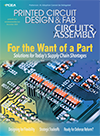Features Articles

When solder isn’t shaped correctly, the condition is known as head-in-pillow.
This month we show the ball surface on area array packages where no solder joint was formed. The joints were intermittent, but one of the surfaces – either the ball or the surface of the solder on the pad – was deformed. This is better known as head-in-pillow (HiP) or head-on-pillow (HoP), depending on the shape formed on the solder adjacent surface.
FIGURES 1 and 2 show examples of HiP/HoP. In Figure 1, the surface of the ball is shown after mechanically separating the device from the board. The indent of the solder from the pad on the board is visible.

Not sure how to tackle an alignment issue? These tips might help set you straight.
In today’s slang, a “life hack” is any trick, shortcut, or proven workaround for a given task that increases productivity and efficiency. And, as regular readers will be acutely aware, this column’s focus is all about improving printing productivity and efficiency. So, I thought a series of “screen-printing hacks” might be helpful to engineers, no matter the level of experience. Throughout 2020, this space will periodically delve into various screen-printing hacks; an issue central to a good print outcome will be identified, and I’ll cover some ways to get the process back on track if something goes awry. The first installment of our screen-printing hack series is alignment.
The goal for the printing process is 100% alignment; the solder paste must align with the feature (the pad) on the substrate. When the solder paste inspection (SPI) system indicates this is not the case and offsets (paste not centered on the pad) are present, an alignment issue is most likely the culprit. Where do you start? Here’s a list of the most common causes and potential fixes; i.e., hacks:

Does Moore’s law apply to the new HI frontier?
The IEEE International Electron Devices Meeting (IEDM) held a night panel discussion on Dec. 10 titled Rest in Peace Moore’s Law, Long Live AI. As the title suggests, the discussion focused on the future of computing and the role of hardware. The moderator proposed questions like will CMOS technology become commoditized and differentiation occur mostly in circuit design, algorithm and architecture development? Will special purpose coprocessor adoption rates accelerate beyond CPUs and GPUs? What is the role of heterogeneous integration in the AI hardware ecosystem? Will the traditional memory hierarchy be upended by the arrival of non-volatile memory? Will analog accelerators using non-volatile memory elements drive the future semiconductor roadmap as scaling slows, enabling exponential improvements in compute efficiency and performance? Not all the questions were answered, but the discussion was lively.

Why the “rise of the robots” might be a good thing for workers.
Once a year, I like to take a column to look at the trends I’m seeing for the coming year. I think 2020 is going to be fairly good for the electronics manufacturing services (EMS) industry.
The trade war finally appears to be cooling down. Both China and the US have been hurt by it, and I think both sides have reached the point where they realize that not reaching an agreement will cost both of them lucrative manufacturing sectors, since China is seeing production migrate to Southeast Asia, and the US is seeing production move to Mexico. As I write this, the phase 1 deal has yet to be signed. If it does get signed in early-2020 and tariffs begin to lift, that could remove the trade-war-driven drag on the US manufacturing economy. The signing of USMCA will also have some positive effects and hopefully improve the competitiveness of US manufacturing within North America.

The technologies that succeed will likely be variations on our current ones.
A new year is always exciting. Thoughts of embarking on new initiatives provide opportunity and inspire everyone to dream big and make them happen. When the new year happens to coincide with a new decade – in this case, the ’20s, or as some of my business colleagues are calling it, “the roaring ’20s” – one can’t help but dream extra big and forecast events that should or could impact our industry in the decade ahead.
Rather than focus on the geopolitical and global economics that clearly impact everyone, too often in an irrational or political way, I will focus on the area I am probably least qualified to opine on: technology.
In the rearview mirror of the past decade(s) have been notable technological disappointments. By “disappointments” I am not saying failures, but technologies, materials and processes that have, so far, not lived up to the hype garnered when first released. Organics, especially OSPs, showed great promise. After many years of refinement, however, the short shelf-life of these surface finishes still makes them too problematic for general use. Yes, they work great in a high-volume, rapid fab-to-assembly-to-OEM application, but for high-mix or ruggedized environments they aren’t ready for prime time.

The Designers Council is dead. Long live the Designers Council!
As the calendar turned to January, IPC and the entity formerly known as the Designers Council amicably parted ways.
The event, which happened quietly after months of discussions, ended a long and productive chapter in the printed circuit design industry history.
As detailed in our 25-year retrospective on the organization in 2017 (https://pcdandf.com/pcdesign/index.php/editorial/menu-features/12246-designer-council-1712), the Designers Council began as an independent grassroots movement in locales across the US and Europe. Originally a confederacy of like-minded individuals who somehow found the energy and time to commit to bringing their colleagues together, it quickly spun into a top-down organization under the auspices of IPC.
Press Releases
- Altus Group Expands Aftersales Team to Its Largest Size to Date
- Incap Estonia Invests in New Flying robe System to Advance Production Performance
- Critical Manufacturing Partners with Canonical to Expand Cloud-Native Deployment Options for Manufacturers
- Heller Industries Becomes the Latest Partner to Join THE SMT FUTURE EXPERIENCE


